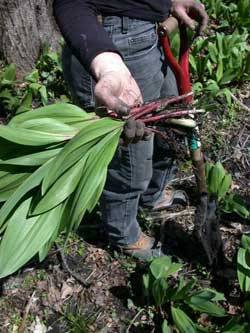 By the time most people tramp through the woods looking for morels at the beginning of May, they’ve already missed one best wild foods nature has to offer. Growing in the low-lying parts of area woodlands with their bright green, oval leaves from March through April, ramps look for all the world like lily of the valley.
By the time most people tramp through the woods looking for morels at the beginning of May, they’ve already missed one best wild foods nature has to offer. Growing in the low-lying parts of area woodlands with their bright green, oval leaves from March through April, ramps look for all the world like lily of the valley.
Take a shovel to them and you’ll see a magenta streaked stem. Take a whiff and you’ll realize they are definitely part of the allium family. Pungent smell aside, ramps are the sweetest of the wild onions. And in Central Illinois, ramps grow even sweeter than domesticated Vidalia onions. Really — Marty Travis has the brix numbers to prove it.
Travis, his wife Kris, and son, Will, operate Spence Farm near Fairbury, Illinois. The Travises began harvesting and selling the ramps when the plants began crowding out some of the native wildflowers in their cousin’s woodland six or seven years ago. One clump of ramps can produce as many as 60 bulbs. In addition to ramps, the Spences market a variety of native and heirloom crops, and heritage animals from their 160-acre farm. Included in their plantings are Galapagos tomatoes, a nearly extinct corn variety, and beans that were a gift from the Kickapoo to Marty’s 4th great grandfather. The family is committed to treading lightly on the land. Their delivery van, which they share with two other farms, runs on used vegetable oil from the restaurants they supply in Champaign and Chicago.
Speaking of Chicago, each spring as many as 85 chefs from there and across central Illinois gather with the Travises for an annual ramp dig. Many of the ramps are used for the Land Connection’s RampFest fundraising dinner.
If you would like to start your own ramps, the Spences will be happy to sell you seed this fall. Be advised that growing ramps in quantity will take a few years. In the meantime, if you want to cook up some Spence ramps, you can find them locally at the Saturday market at Prairie Fruits Farm north of Urbana.
Use ramps like onions on pizzas, sandwiches, and in salads, says Marty. “Grill them or sauté them,” he says. This week Marty sautéed ramps with butter, purple cabbage, and some liquid from pickled beets. You also can use the leaves to flavor fish by wrapping them around it prior to steaming or baking.
Terra Brockman, founder of the Land Connection, suggests using ramps in omelets, quiches, and other egg dishes. Since you have to go to Prairie Fruits to purchase them, she recommends pairing them with the farm’s fresh goat cheese. I like her recipe without the garlic, but it’s up to you.
Ramp Goat Cheese Pasta
submitted by Terra Brockman
- 15-20 ramps
- 4 T olive oil
- 1 clove garlic, thinly sliced
- 1 pound linguine, spaghetti, or other pasta
- ¼ cup fresh chevre (or more)
- Grated Pecorino Romano cheese, to taste
Put a large pot of salted water on to boil and begin cooking the pasta.
Clean the ramps, removing the translucent husk over the bulb if they are freshly dug. Slice the stems into ½ to 1 inch lengths, and coarsely chop the greens.
Heat the olive oil in a large sauté pan until just smoking, then pull the pan off the flame, toss in the ramp stems, and toss well. Return to the heat and sear until blistered, brown, and soft. Reduce the heat and add the garlic to the pan, tossing until toasted.
Drain the pasta as soon as it is al dente, then add it to the pan, along with the ramp leaves and toss until wilted. Stir in the chevre. Transfer to serving plates and grate Pecorino over the top. Finish with a little olive oil, if desired.
Photo courtesy of The Land Connection








